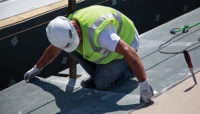How Should Roofers Address Deck Protection?

I try to stay in my lane when it comes to the content of this column. It is commentary on the things that I see, the people I meet, and the overall state of life in the roofing industry. For that reason, I typically avoid the technical topics. Elsewhere in this issue of Roofing Contractor and on roofingcontractor.com you will find some great technical information on winter roof maintenance, specifically on ice dams and deck waterproofing.
I’ve long had a problem with ice barriers installed over plywood decks that are covered with asphalt shingles or concrete tile.
I’m fairly certain that, as with many roofing details, peel-and-stick membranes are overused, underused, improperly used, and otherwise abused by contractors who only view them as an “extra” or “best quality” addition to their roofing projects. I’m also certain that these membranes are installed properly and do a great job of protecting the structure from the collateral damage of ice and moisture buildup beneath the primary roof coverings.
But it doesn’t upset me that many contractors are still learning how to specify and apply these membranes. It has been decades, but their introduction into codes and warrantied shingle systems is still relatively fresh. I’m sure everyone is getting better.
What gets my goat is what happens when the roof becomes damaged or wears out. Is it acceptable to remove the shingles, leave the previously-installed deck waterproofing membrane alone (so long as it is still functional)? Better read your warranty and consult with your local codes, or manufacturer’s instructions. You may find there’s a very narrow path to leaving the membrane and roofing over it.
It would seem the best course would be to remove it and expose the deck. Number one, to make sure the deck is suitable for roofing over; and number two, to install a fresh new deck waterproofing membrane. The trouble with this is you’re not going to unstick a peel-and-stick that’s been there 10, 20, or 30 years.
The membrane meant to protect the deck will guarantee the destruction of the deck, causing it to be removed and replaced at the same time the roof is replaced. True, the rest of the structure should be protected by the membrane, so you are saving trusses, rafters, fascia, soffits, and other building members.
But do you have to replace the deck? Do we not have a better solution than this?
Again, I’m not the technical expert in the family. But I do wonder if there isn’t a liquid-applied membrane that could serve as a deck protection course that could be refreshed at retrofit time. Are liquid-applied solutions too expensive or too difficult to install? Are none approved by codes? Am I dreaming (again)?
In addition to seldom weighing in on technical topics, I seldom include a direct call to action. This time I do. I invite you to share your thoughts with me and your fellow readers. What is your solution for reroofing over deck protection membranes? Do you always recommend deck replacement? Do you always just roof over them? Do you install another course of membrane or just nail over?
Click here to share your thoughts. I look forward to hearing from you.
Looking for a reprint of this article?
From high-res PDFs to custom plaques, order your copy today!






